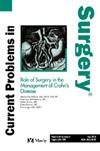Optimizing Outcomes in Anastomotic Recurrence of Rectal Cancer: Efficacy of Transanal Total Mesorectal Excision
IF 1.9
3区 医学
Q2 SURGERY
引用次数: 0
Abstract
Purpose
Anastomotic recurrent rectal cancer (ARRC) remains a formidable challenge worldwide. The transanal total mesorectal excision (taTME) technique, with its unique bottom-up approach, offered a potential advantage in addressing this issue by providing improved visibility and precision in dissection. Therefore, this study aimed to explore the potential of taTME for managing ARRC, investigating its safety and efficacy and patient well-being.
Methods
ARRC patients who underwent radical surgical treatment from January 2016 to July 2023 in two high-volume centers were enrolled in the study. Patients were assigned into taTME group and non-taTME group based on the surgery approach used. The perioperative, pathological, and short-term follow-up results were analyzed and compared between the two groups.
Results
72 patients were enrolled in this study. 18 patients received the taTME procedure, while the remaining 54 underwent alternative procedures. The taTME group exhibited more favorable perioperative outcomes, including reduced hospital stays [8.00 (7.00 – 8.00) days vs. 9.00 (7.00–18.00) days, P=0.046) and time to first flatus [36.00 (30.00 – 42.00) hours vs. 72.00 (63.00–74.00) hours, p<0.001]. Intraoperatively, the taTME group showed a lower morbidity of intraoperative adverse events compared to non-taTME group (16.67% vs. 48.14%, p=0.026). Especially, the non-taTME group had a higher incidence rate of the incorrect dissection plane. Postoperatively, no significant differences were found in postoperative complications two groups. Two patients undergoing taTME surgery suffered from anastomotic leakage. While in the non-taTME group, the most common postoperative complications were postoperative infection and defecation disorder, accounting for 18.52% and 20.83% respectively. The taTME group had more advantages in obtaining complete TME specimen than the non-taTME group (100% vs. 77.78%, p=0.030). Besides, no cases of positive CRM and DRM were reported in the taTME group. All of these ensured R0 resection. The median follow-up time was 21.00 (11.25 - 27.75) months, and 6 patients in the non-taTME group experienced recurrence and subsequently passed away due to tumor progression, totally.
Conclusion
This study presented taTME as a promising surgical approach for ARRC patients due to its advantages in precise dissection plane identification, which highlighted its potential in ensuring R0 resection, anal preservation and superior perioperative outcomes. These results suggested taTME could potentially be a new surgical option in patient recovery and postoperative quality of life for ARRC patients.
直肠癌吻合口复发的最佳预后:经肛门全肠系膜切除术的疗效
目的吻合口复发性直肠癌(ARRC)在世界范围内仍然是一个巨大的挑战。经肛门全肠系膜切除术(taTME)技术,以其独特的自下而上的入路,提供了一个潜在的优势,在解决这个问题,提供了更高的可见性和精确的解剖。因此,本研究旨在探讨taTME治疗ARRC的潜力,调查其安全性、有效性和患者福祉。方法纳入2016年1月至2023年7月在两个大容量中心接受根治性手术治疗的sarrc患者。根据手术入路将患者分为taTME组和非taTME组。分析比较两组患者围手术期、病理及短期随访结果。结果72例患者入组。18例患者接受了taTME手术,其余54例患者接受了其他手术。taTME组表现出更有利的围手术期结果,包括住院时间缩短[8.00(7.00 - 8.00)天vs. 9.00(7.00 - 18.00)天,P=0.046]和首次放屁时间缩短[36.00(30.00 - 42.00)小时vs. 72.00(63.00-74.00)小时,P= 0.001]。术中,taTME组术中不良事件发生率低于非taTME组(16.67% vs 48.14%, p=0.026)。特别是非tatme组解剖平面不正确的发生率较高。术后两组患者术后并发症无明显差异。2例患者行taTME手术后出现吻合口瘘。而非tatme组最常见的术后并发症为术后感染和排便障碍,分别占18.52%和20.83%。taTME组在获得完整TME标本方面优于非taTME组(100% vs. 77.78%, p=0.030)。此外,taTME组未报告CRM和DRM阳性病例。所有这些都保证了R0的切除。中位随访时间为21.00(11.25 ~ 27.75)个月,非tatme组共有6例患者复发后因肿瘤进展而死亡。结论taTME在精确识别解剖平面方面具有优势,在保证R0切除、保留肛门和良好的围手术期预后方面具有潜力,是ARRC患者的一种有前景的手术方式。这些结果表明taTME可能是ARRC患者恢复和术后生活质量的一种新的手术选择。
本文章由计算机程序翻译,如有差异,请以英文原文为准。
求助全文
约1分钟内获得全文
求助全文
来源期刊
CiteScore
5.20
自引率
0.00%
发文量
47
审稿时长
18 days
期刊介绍:
Current Problems in Surgery keeps readers up-to-date on the latest surgical advances. Each month, this publication examines a single clinical problem or condition commonly seen by general surgeons. Issues also focus on topics in surgical research and emerging ideas in surgical subspecialties. Current Problems in Surgery is ideal for information too urgent to await book publication, yet too important to be summarized in a brief journal article.

 求助内容:
求助内容: 应助结果提醒方式:
应助结果提醒方式:


